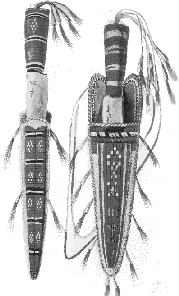
Eastern Great Lakes Knife Sheathes (Amer. Ind. Art. Spring 1993). |
Copper & Brass Metalwork
|

Eastern Great Lakes Knife Sheathes (Amer. Ind. Art. Spring 1993). |
Copper & Brass Metalwork
|
Native Americans in the Northeast traditionally use copper and brass sheet metal to make utensils and tools including pots, spoons, arrow points and pipes, as well as jewelry including tinkling cones, beads, bracelets, and rings. Natives of the Northeast were well acquainted with working indigenous copper long before the invasion by Europeans in the 1500s (Brasser 1978) and rare items were made from the great quantity quantities of copper around Lake Superior in archaic times (Beauchamp 1902). There are also large copper deposits in Virginia, North Carolina, Tennessee, Arizona, New Mexico, and Nova Scotia (Orchard 1975). Twelve ounces of pure copper were obtained from a pound of ore from the French operated copper mine at Port Royal (Josselyn 1972; Lindholdt 1988). But even thousands of years ago, following Native American trade networks, copper tools and ornaments were brought into the New England region (Rainey 1936, Brasser 1978). Small globe-shaped beads of indigenous copper come from New York, Nova Scotia and New Brunswick (Beauchamp 1903, Orchard 1975), and beads from Tennessee made from copper nuggets were hammered thin, rolled, and hammered again into shape, showing distinct layering (Orchard 1975).
Smelted European copper and brass (alloys mainly of copper with smaller amounts of zinc and other elements) reached the central East coast by the 1500s (Brasser 1978). By 1524, the European explorer Verrazzano saw many sheets of worked copper which Natives of New England possessed. "They do not value gold because of its color; they think it the most worthless of all, and rate blue and red above all other colors... the same was true for metals like steel and iron, for many times when we showed them some of our arms, they did not admire them, nor ask for them, but merely examined the workmanship. They did the same with mirrors; they would look at them quickly, and then refuse them, laughing." [Verrazzano 1970]
With the onset of the 1600's the Natives "have also great store of copper, some very red, and some of a pale color: none of them but have chains, earrings, or collars of this metal; they head some of their arrows herewith, much like our broad arrowheads, very workmanly done" (citing John Brereton in Beauchamp 1903). Beauchamp believes that some of this was European metal, the ‘pale copper’ being brass or bronze; though Brereton said that the Native Americans indicated that some of it had been mined on the mainland. Nevertheless, European metals were being worked by Natives along the coast by the year 1600, and some of it had even begun to reach areas of the interior (Beauchamp 1903).
Native-made copper and sheet metal items were a valuable commodity which were often traded to Europeans to obtain materials made of iron and steel. John Brereton, while sailing through the Elizabeth Islands off Massachusetts in 1602, mentioned that Natives "offered their fairest collors or chains, for a knife or such like trifle." (Rainey 1936). Coastal Native Americans helped Gosnold find the products he sought by offering European traders native-made items including copper pipes, in exchange for knifes, hatchets, and other items (Vaughan 1979).
Copper items on the coast from the Massachusetts to Maine southern Maine could have been traded from French and Basque fishermen who traveled here before 1600 (Beauchamp 1903, Rainey 1936). Narragansett, Wampanoag and other Natives of New England were often buried with items of copper or brass received through trade (Simmons 1970, Gibson 1980). The Micmac in the 1600s show a recognition of the working characteristics of metal when a man took a corroded kettle from a grave and struck against it to demonstrate that the kettle no longer made a sound "because it is dead, and its soul has gone to the land where the souls of kettles are accustomed to go" (Simmons 1970).
By the late 1600’s Native Americans in New England preferred kettles of brass, copper, or iron, to those made of clay by Native Americans (Gookin 1970); but not necessarily valued for their intended European purpose of cooking. By 1634, iron pots were preferred for cooking more than brass (Wood 1865); iron and steel tools made those of copper and stone obsolete (Jennings 1976). Although some sheet metal items were manufactured in Europe, many other copper and brass objects were worked up from broken kettles (Beauchamp 1903). These kettles and other European items were so valuable to Natives mainly because they could produce so many new objects from the recycled sheet metal.

© 1994-1999 Tara Prindle.